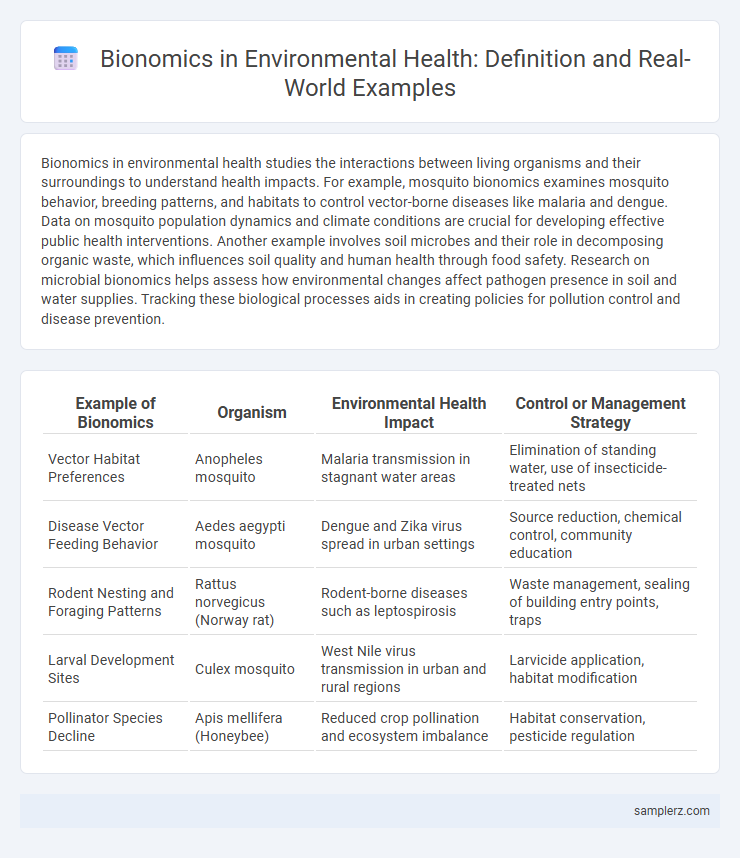Bionomics in environmental health studies the interactions between living organisms and their surroundings to understand health impacts. For example, mosquito bionomics examines mosquito behavior, breeding patterns, and habitats to control vector-borne diseases like malaria and dengue. Data on mosquito population dynamics and climate conditions are crucial for developing effective public health interventions. Another example involves soil microbes and their role in decomposing organic waste, which influences soil quality and human health through food safety. Research on microbial bionomics helps assess how environmental changes affect pathogen presence in soil and water supplies. Tracking these biological processes aids in creating policies for pollution control and disease prevention.
Table of Comparison
| Example of Bionomics | Organism | Environmental Health Impact | Control or Management Strategy |
|---|---|---|---|
| Vector Habitat Preferences | Anopheles mosquito | Malaria transmission in stagnant water areas | Elimination of standing water, use of insecticide-treated nets |
| Disease Vector Feeding Behavior | Aedes aegypti mosquito | Dengue and Zika virus spread in urban settings | Source reduction, chemical control, community education |
| Rodent Nesting and Foraging Patterns | Rattus norvegicus (Norway rat) | Rodent-borne diseases such as leptospirosis | Waste management, sealing of building entry points, traps |
| Larval Development Sites | Culex mosquito | West Nile virus transmission in urban and rural regions | Larvicide application, habitat modification |
| Pollinator Species Decline | Apis mellifera (Honeybee) | Reduced crop pollination and ecosystem imbalance | Habitat conservation, pesticide regulation |
Understanding Bionomics in Environmental Health
Bionomics in environmental health examines how the behavior, life cycles, and interactions of organisms impact ecosystem stability and public health. Studying mosquito bionomics, for example, reveals patterns in breeding sites, feeding behavior, and population dynamics critical for controlling vector-borne diseases like malaria and dengue. This ecological insight supports targeted interventions that reduce pathogen transmission and improve community health outcomes.
Key Principles of Bionomics Applied to Health
Bionomics in environmental health emphasizes the interaction between organisms and their surroundings to manage disease vectors effectively. Key principles include understanding the life cycle, habitat preferences, and population dynamics of vectors such as mosquitoes to design targeted control strategies. Applying these concepts reduces the incidence of vector-borne diseases by promoting sustainable environmental management and minimizing human exposure.
Vector-Borne Diseases: Bionomics of Mosquitoes
The bionomics of mosquitoes plays a crucial role in understanding and controlling vector-borne diseases such as malaria, dengue, and Zika virus. Mosquito behavior, breeding habitats, and feeding patterns directly influence disease transmission dynamics and guide targeted vector control strategies. Effective environmental health interventions rely on detailed knowledge of mosquito life cycles and ecological preferences to reduce human-vector contact and minimize disease outbreaks.
Bionomics and the Spread of Waterborne Pathogens
Bionomics examines the interactions between organisms and their environments, providing critical insights into the spread of waterborne pathogens like Vibrio cholerae and Escherichia coli. Understanding the life cycles and habitats of aquatic microorganisms helps predict contamination events and design effective water treatment strategies. This ecological approach supports the development of targeted interventions to reduce outbreaks of diseases such as cholera and dysentery in affected communities.
Environmental Factors Influencing Disease Vectors
Environmental factors such as temperature, humidity, and vegetation significantly influence the bionomics of disease vectors like mosquitoes and ticks, determining their breeding, survival, and distribution patterns. Urbanization and deforestation alter natural habitats, creating favorable conditions for vector proliferation and increasing the risk of vector-borne diseases such as malaria and Lyme disease. Understanding these ecological dynamics enables targeted vector control strategies and effective public health interventions.
Bionomic Approaches to Pest Control in Public Health
Bionomic approaches to pest control in public health leverage the ecological relationships and life cycles of pests to reduce their populations effectively and sustainably. Techniques such as introducing natural predators, manipulating pest habitats, and employing pheromone traps help control disease vectors like mosquitoes, reducing the spread of vector-borne diseases such as malaria and dengue. These methods minimize reliance on chemical pesticides, lower environmental impact, and promote long-term public health safety.
Case Study: Bionomics of Malaria Transmission
Malaria transmission dynamics are profoundly influenced by the bionomics of Anopheles mosquito vectors, including their breeding habitats, feeding behaviors, and seasonal population fluctuations. Understanding these ecological and behavioral patterns enables targeted interventions such as larval source management and insecticide-treated nets, significantly reducing malaria incidence. Case studies highlight that environmental modifications disrupting vector life cycles effectively lower disease transmission in endemic regions.
Impact of Urbanization on Vector Bionomics
Urbanization significantly alters vector bionomics by expanding breeding habitats for disease vectors such as mosquitoes, particularly Aedes aegypti and Anopheles species, increasing the risk of vector-borne diseases like dengue and malaria. Changes in temperature, humidity, and water management practices in urban areas modify vector population dynamics, feeding patterns, and lifespan. Understanding these impacts is crucial for developing targeted vector control strategies to mitigate public health risks in rapidly urbanizing environments.
Climate Change and Vector Bionomics in Health
Climate change significantly alters vector bionomics by expanding the geographical range and breeding seasons of disease-carrying organisms like mosquitoes, increasing the risk of vector-borne diseases such as malaria and dengue fever. Rising temperatures and changing precipitation patterns influence vector survival rates, population density, and pathogen transmission dynamics, impacting environmental health outcomes. Understanding these climatic effects on vector bionomics is crucial for designing targeted public health interventions and climate-adaptive disease control strategies.
Integrating Bionomics into Environmental Health Policies
Integrating bionomics into environmental health policies enhances disease vector control by studying the behavior, life cycles, and habitats of organisms like mosquitoes and ticks that transmit pathogens. This approach supports targeted interventions to reduce vector-borne diseases such as malaria, dengue, and Lyme disease, improving public health outcomes. Effective policy implementation relies on ecological data and community engagement to sustain environmental balance while minimizing health risks.

example of bionomics in environmental health Infographic
 samplerz.com
samplerz.com